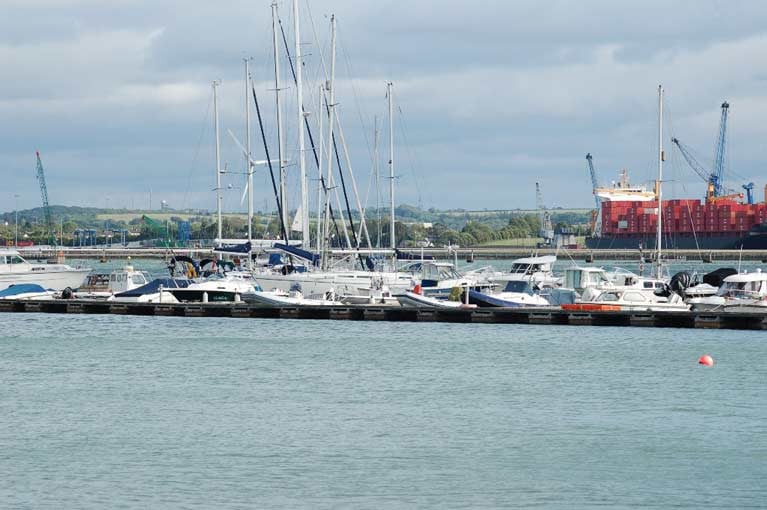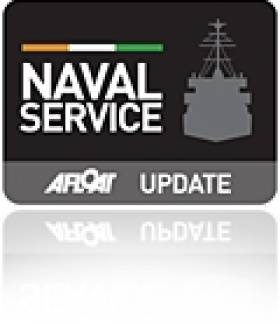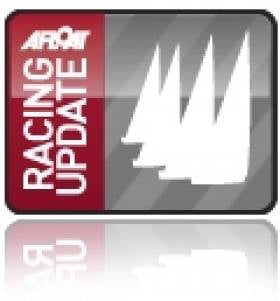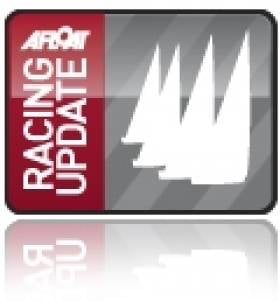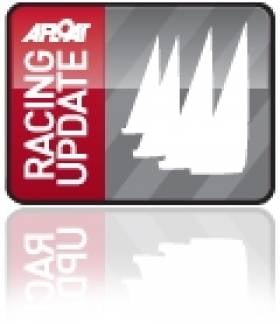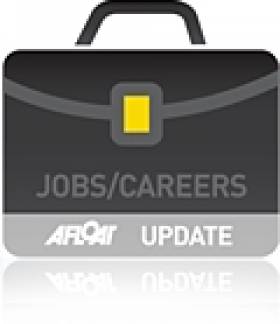Displaying items by tag: racing
I'd Like to Go Yacht Racing This Season - But...
The sight of more masts appearing on the marina in my village of Monkstown on the edge of Cork Harbour was encouraging this week. Not that I have any disregard for the motorboat community who populate the Cork Harbour Marina year-round, but in this difficult and challenging season, it was good to see more yacht masts in the marina and other yachts going onto their moorings in Monkstown Bay.
That was the good news. The disappointing news was from Sail Training Ireland that they have had to cancel all Tall Ship voyages planned for this year.
Chief Executive Daragh Sheridan said this was inevitable because there was no way the organisation “could ensure the social distancing required to ensure the safety of trainees and crew.”
That is the issue which troubles me about the resumption of cruiser yacht racing.
The Government’s medical advisors and the Minister for Health have been making it clear that, as Mr.Harris has said: “social distancing will be with us for a long time.”
How can social distancing be achieved on a racing yacht?
Two metres is just over six feet, even one metre would be difficult, “impossible” is the description I’ve heard repeatedly in phone calls and read in Emails.
Two instances this week highlighted my thoughts about this “social” or “physical distancing.” One was when I was reminded of a 30-year anniversary and the lack of any “social distance” on my only TransAtlantic race, back in May 1990 as a crew member aboard NCB Ireland on the last leg of that year’s Round the World Race, then known as the Whitbread, from Fort Lauderdale to Southampton - 3,818 nautical miles sailed over 18 days. The crew shared “hot bunking”. Mine was the middle of three where when lying down there wasn’t enough space to raise a book to read.
Social or physical distancing wasn’t possible on the 83-foot NCB and I can’t see it either on Scribbler, the 33-foot Sigma which I sail with my son, grandsons and occasional other crew. We won’t even qualify as a family crew because we are in two households.
 Yacht Racing at the 2019 Volvo Dun Laoghaire Regatta Photo: Afloat
Yacht Racing at the 2019 Volvo Dun Laoghaire Regatta Photo: Afloat
Irish Sailing are doing their best, but there seems little official understanding of the requirements of sailing. How do you keep apart during the demands of racing, when more than one person may be needed to get a sail in or to launch and recover a spinnaker, or what about adding weight on the rail?
Solo racing will be ok, but there aren’t a preponderance of single-household cruiser racing crews, or so it appears from the reaction I’m receiving. Even with the easing of restrictions, the constant message is that social distancing stays in place…. So can cruiser racing be resumed?
All the comments I’m getting seem to be doubtful unless there are major changes in social distancing. I hope there are because I’d like to go sailing and racing this season.
This week’s Podcast is below...
One Point Separates Top Four in Kinsale Spring League Class One IRC (Photo Gallery Here)
Exciting racing is anticipated in next Saturday's Kinsale Yacht Club Spring Series Class One IRC with only one point separating the top four boats writes David Sullivan. Justus and EOS on 12 points followed by Jump Juice and Freya with 13 points. Only one long coastal race is scheduled.
Artful Dodger holds a three-point lead over Slack Alice in Class Two IRC with Bad Company Third.
Sponsor James Matthews, sailing his Ed Dubois quarter tonner Diamond, is making a clean sweep of Class Three IRC with five bullets placing him in an almost unassailable position.
The Spinnaker Fleet on the W/L course saw a SE Zephyr build to a slight breeze. The Race Officer got fleet away to a windward mark just south of Sovereigns. Calm seas downwind saw the fleet keeping north out of the flood tide on the run to leeward mark near Hake Head. Two laps were sailed in the first race with a shortened one-lap course sailed in race two.
Class 1
Jump Juice (C Phelan) got two bullets with Justus (D Buckley) Freya (C Doyle) sharing six points each.
Class 2
Artful Dodger (F O’Regan) got two bullets Slack Alice (S Strathem) second with five points and Bad Company (Desmond/Ivors/Deasy) third on six points.
Class 3
The Ed Dubois quarter tonner Diamond (J Matthews) dominated both races in IRC and is now first overall with Flyover (D Marchant) second and No-Gnomes (L Donnery) third overall in IRC.
The seven boat White Sail fleet White Sail had two excellent races on a Matthews, Kieran Electrical, Bulman Triangle.
White Sail: The McCarthy Brothers are now in first place overall on Baccarat with eight points, Crosshaven boat Sweet Dreams (B&H O’Leary) second and Paragon (D Ackerlind) third.
Full Results here
Racing continues on Saturday 29th FG 11.55 HRS
Race Officers – Siobhan Keane Hopcraft, Denis Kieran, Michele Kennelly & Seamus Caher.
Ireland’s Boats & People – How Do We Get Them Together?
The recently-published ISA Survey of Club Racing commissioned and supervised by Board Member Jack Roy has started the process of putting together a realistic picture of how we sail and go afloat for recreation, and it was analysed on publication here in Afloat.ie.
It’s logical to have made the beginning with club racing, as racing provides its own narrative and a straightforward set of entry numbers and results. But it will become more complex as the national authority tries to provide realistic figures for day sailing’s less competitive aspects. And of course, once we enter the world of cruising as defined by sailing and boating projects which include passage making, both coastal and offshore, together with overnight on-board stops, then it can become much more difficult to get meaningful data.
Yet with the ISA’s Cruising Conference for February 20th already booked out within a few days of being announced on Afloat.ie, clearly that is an area in search of services and support, a section of sailing which is difficult to quantify yet obviously of strong interest to a significant number of boat enthusiasts. W M Nixon takes a look at how the complexity of our sport’s many specialities makes it difficult to provide a clearcut picture for possible recruits to sailing.
Where would we be without the International Optimist Dinghy? The little solo-sailing boxes and their attendant support teams of mum and dad and the dog and the old 4X4 or station wagon or people carrier or whatever may seem to take up an awful lot of space and time, and all just so that one little person can go sailing.
But at least that one little person does go sailing. The ISA figures are brutally straightforward. In terms of genuine turnouts afloat at clubs throughout Ireland, in boat numbers the active Optimists are exceeded only by the Lasers, and this is arguably because Lasers aren’t age-limited, whereas the Optimists most definitely are.

Optimist airborne. This is Ireland's second most popular class
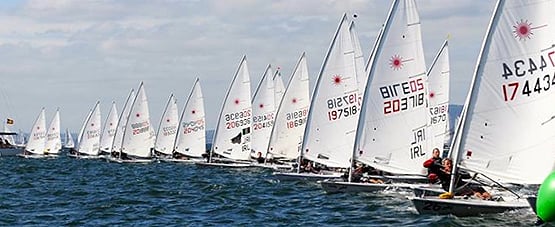
Ireland’s most popular dinghy class, the Laser is seen here at the Zhik Irish Nationals at Ballyholme
So we give a qualified cheer for the success of these two little boats. But it’s qualified because they’re single-handers which fail to provide any crew-relating sailing skills. Leading sailing figures as diverse as Des McWilliam of Crosshaven and Norman Lee of Greystones have been eloquent in promoting the notion that we should be doing more – much more – to encourage two-handed boats, and if we can persuade people into three-handed boats, well, so much the better.
Certainly that’s one of the reasons why our header photo says so much. A lone sailor in an Optimist or Laser promotes too much of a solitary, even an isolated image. And a two-handed boat like the GP 14, whose strong fleet figures in the ISA survey show the class’s vigour, is arguably just an act for a dynamic duo – it’s Strictly Come Dancing goes sailing…..
But getting three together to race a characterful boat like the National 18 with style – now that’s something special, that really is a superb combination of people skills interacting with sailing talent. And it’s a joy to behold. Yet anyone can see that for a complete beginner to sailing, this extraordinary silhouette of Tommy Dwyer’s National 18 against the November sky above the Hill of Howth will have an otherworldly air about it – “That’s not for me” is as likely a response as “Let’s have a go at that”.
Even those of us who have been in sailing for longer than we care to remember find the image decidedly thought-provoking, for we have some idea of what has been involved in creating the circumstances for this seemingly effortless balancing act, this lighter-than-air effect in the unlikely setting of a November afternoon.
Over the past year or so we have been recounting in Afloat,ie how the Cork Harbour National 18 Class, with very tangible backing from the Royal Cork Yacht Club, have been in the forefront of the development of the new ground-breaking Phil Morrison take on the long-established National 18, which is a developmental class which from time to time takes a leap in hull design, and moves forward in order to keep the spirit alive.
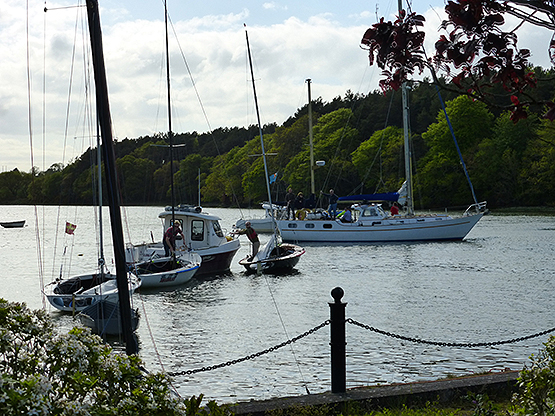
The National 18s are part of the fabric of Cork Harbour sailing. Before the new Morrison boats arrived in July, the old fleet were seen here in May 2015 after their annual race to Ballinacurra in northeast Cork Harbour in company with the Dwyer brothers’ cruising ketch. Photo: W M Nixon
Acceptance of this is something which seems to be bred into Cork’s National 18 enthusiasts, many of whom have the advantage of being firmly of the opinion that a proper dinghy needs three people to sail it. But the social matrix which has built up around Cork Harbour over many decades with this concept at its heart is not something which will necessarily travel easily to other areas, and although the six boats of the National 18 flotilla which visited Howth for the Open Day got a great reception and gave many people from other classes a marvellous time afloat, it’s probable that the very different mood around sailing in Dublin means that something so technically and socially challenging as a three man dinghy is a step too far.
Sailing in the greater Dublin area seems to exist within a framework of independent balloons. While there are those who will happily move from one boat type to another and cheerfully spread their talents and enjoyment about, by contrast there’s the Dublin Bay Sailing Club Thursday Evening Phenomenon.
Thursday is when the DBSC cruiser classes go out to race. And there’s an entire cohort of people, mostly folk who work in offices in the city, who on a Thursday evening go straight to Dun Laoghaire, get aboard a pontoon-based cruiser owned by someone else, go out and race in some very specific crewing job, then come back in and have supper in club or pub with their shipmates, and then that’s it until next Thursday. Just one evening each summer mid-week is their entire sailing programme. Weekends are for something else. And as for the hassle and mixed joys of boat ownership and maintenance, that’s not their department at all.
It’s a very metropolitan, very citified yet specialized way of doing things, and Dublin is one of the very few cities whose location facilitates it. It will be fascinating to measure it, for Dublin’s way of sailing is steeped in history and tradition. But for now it’s refreshing to look at a place which has had a sailing tradition in times past, but somehow lost it, yet it’s coming back again, and one of the good news stories towards the end of 2015 is that the new Youghal Sailing Club has been accepted into the ISA fold.
Youghal at present is a difficult place for sailing, as the tidal power of the mighty Munster Blackwater sweeps straight through the estuary and along the old town’s waterfront, and the creation of any meaningful modern facilities will have the immediate difficulty of silting by incredibly adhesive black mud.

With the sun out, and the tide in, Youghal looks to be an ideal location for the easy installation of a marina….....Photo: W M Nixon
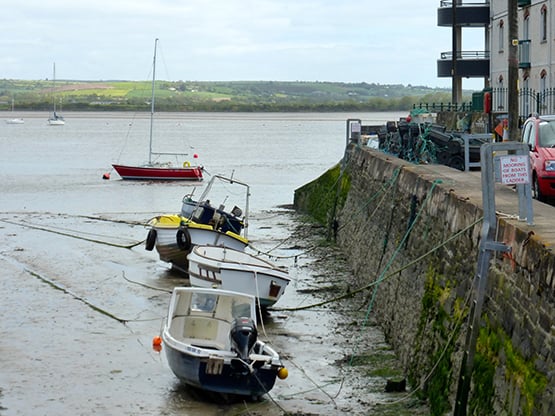
….but with the sun in and the tide out, the mud problem is revealed. Photo: W M Nixon
Thus, as dedicated Afloat.ie readers will have recently observed, no sooner had one group announced that a marina in Youghal was on the way than another longer-established group quietly suppressed the story, as they’re well aware of the engineering and dredging difficulties involved, and premature announcements will only slow any project in the long run.
In the fullness of time, a marina at Youghal will be a godsend for any cruiser plugging along the south coast. It’s not always the easiest coast in the world to make a passage along, sometimes it can seem an awfully long way to Cork from Dunmore East or Kilmore Quay even if you do make stopovers at Dungarvan or Helvick, and there are times when the hardiest seafarer is glad enough to get his boat secured to a good big pontoon.
But that’s for the future. Meantime, the locally-based keelboats are using either the restless anchorage off the town, or the more serene pool across the estuary at Ferry Point on the east shore, while the new club’s flotilla of GP 14s are stored in spare warehouse space during non-sailing time, and when they do go sailing it turns out their clubhouse is a moveable feast - it’s a caravan which can be towed to a choice of sailing locations.
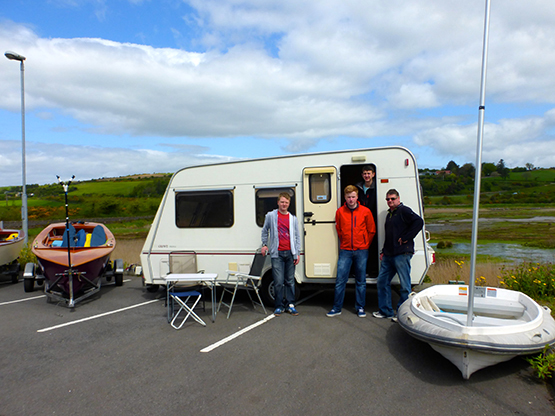
A moveable feast. Members of the newly-affiliated Youghal Sailing Club with their caravan HQ, Adrian Lee in doorway. Photo: W M Nixon
On the national stage, it is young Youghal GP 14 sailor Adrian Lee who has been among those flying the club’s flag, and there’s hope in the air. When we were there in May on a fine day that promised a summer which never arrived, we couldn’t help but think that when they do get their facilities and maybe even a clubhouse, they’ll look back to the days of the caravan and ad hoc racing arrangements with sweet nostalgia. For sometimes, it’s much better to be travelling than it is to arrive.
But for the rest of us, the message from Youghal is simple. The sea is for sailing. Use it or lose it. By all means get proper people surveys done which indicate the way numbers are shaping up and things are going. But really, if you want to persuade people to go sailing, the best way is by example, getting afloat as much as possible yourself. And maybe then you’ll find the time to welcome aboard newcomers too.

Reviving Youghal sailing – on race days, the club’s caravan is simply towed down to the pier and the races are started from there. Photo: W M Nixon
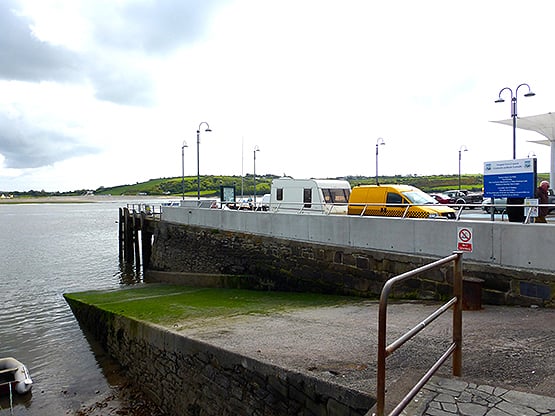
Youghal’s massive public slip provides launching for the YSC sailing dinghies, but during 2015 the boats had to be stored at the other end of town when not in use. Photo: W M Nixon
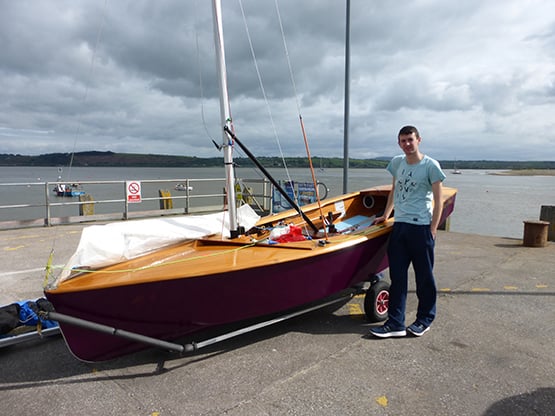
The pace-setter. Adrian Lee of Youghal SC with his Duffin-built GP14. Photo: W M Nixon
Click to download: ISA Survey of Club Racing
DMYC Cancels September Series Over Poor Participation
#Racing - The Dun Laoghaire Motor Yacht Club (DMYC) has cancelled its September Series for 2015 due to poor particpation, with only two boats entering the series.
In a statement, the club said: "We cannot in good conscience offer racing with that few boats, nor ask multiple volunteers to give their time."
In the series' stead, the DMYC will be running two Kish races, one for single- and double-handed boats (date to be confirmed) and another for fully crewed vessels scheduled for Sunday 27 September.
Women's Open Keelboat Championship Returns In 2015
#Racing - The UK Women's Open Keelboat Championship returns in 2015 after a year off, as The Daily Sail reports.
The event is again title-sponsored by Irish boat shoe specialists Dubarry – and that Irish connection continues in the form of 2013's champions, led by Howth Yacht Club's Laura Dillon.
It's not yet known if the same team will return to defend their title, but entries will open early next month for this September's championship at the Hamble River Sailing Club in Southampton, with racing scheduled for the earlier weekend of 30-31 May.
The Daily Sail has more on the story HERE.
Dublin Bay Sailing Club (DBSC) Results for Saturday 23 August 2014
#DBSC - BENETEAU 31.7 Echo: 1 Legally Blonde (C Drohan/P Egan) ; 2 Thirty Something (Kavanagh\Gaffney\Jones) ; 3 Levante (M Leahy/J Power)
BENETEAU 31.7: 1 Levante (M Leahy/J Power); 2 Legally Blonde (C Drohan/P Egan); 3 Kernach (Eoin O'Driscoll)
CRUISERS 0 Echo: 1 Lively Lady (Derek Martin)
CRUISERS 0: 1 Lively Lady (Derek Martin)
CRUISERS 1 Echo: 1. Raptor (D Hewitt et al); 2 Jigamaree (R Harris); 3 Jalapeno (P Barrington et al)
CRUISERS 1: 1 Raptor (D Hewitt et al); 2 Jalapeno (P Barrington et al); 3 Jigamaree (R Harris)
CRUISERS 2 Echo: 1 Red Rhum (J Nicholson/C Nicholson); 2 Jawesome 111 (M Dyke/B Darcy); 3 Bendemeer (L Casey/D Power)
CRUISERS 2: 1 Red Rhum (J Nicholson/C Nicholson); 2 Jawesome 111 (M Dyke/B Darcy); 3 Graduate (D O'Keeffe)
CRUISERS 3 Echo: 1 Hard on Port (Flor O'Driscoll); 2 Quest (J Skerritt); 3 Cri-Cri (P Colton)
CRUISERS 3: 1 Quest (J Skerritt); 2 Hard on Port (Flor O'Driscoll); 3 Cri-Cri (P Colton)
FIREBALL Race 1: 1 Licence to Thrill (Louis Smyth); 2 Blind Squirrel (Frank Miller)
FIREBALL Race 2: 1 Licence to Thrill (Louis Smyth); 2 Blind Squirrel (Frank Miller)
FLYING FIFTEEN Race 1: 1 Flyer (Niall Coleman); 2 The Last Resort (John O'Sullivan); 3 Kooigjug (K Dumpleton)
FLYING FIFTEEN Race 2: 1. Kooigjug (K Dumpleton); 2 Gulfstream (A Cooper); 3 Snow White (Frank Burgess)
GLEN: 1 Pterodactyl (R & D McCaffrey); 2 Glenluce (D & R O'Connor); 3 Glendun (B Denham et al)
IDRA 14 FOOT Race 1: 1 Dunmoanin (Frank Hamilton); 2 Squalls (Stephen Harrison); 3 Dart (Pierre Long)
IDRA 14 FOOT Race 2: 1 Dunmoanin (Frank Hamilton); 2 Squalls (Stephen Harrison); 3 Dart (Pierre Long)
MERMAID Race 1: 1 Jill (P Smith/P Mangan); 2 Aideen (B Martin/D Brennan)
MERMAID Race 2: 1 Jill (P Smith/P Mangan); 2 Aideen (B Martin/D Brennan); 3 Tijuana (David Stedmond)
RUFFIAN 23: 1 Ruff Nuff (D & C Mitchell); 2 Ripples (Frank Bradley); 3 Bandit (Kirwan/Cullen/Brown)
SIGMA 33: 1 Gwili Two (D Clarke/P Maguire); 2 Springer (I Bowring); 3 Popje (Ted McCourt)
SQUIB Race 1: 1 Perfection (Jill Fleming); 2 Little Demon (Sheila Power); 3 Anemos (Pete & Ann Evans)
SQUIB Race 2: 1 Perfection (Jill Fleming); 2 Anemos (Pete & Ann Evans); 3 Tears in Heaven (M Halpenny/G Ferguson)
WHITE SAIL CRUISERS Echo: 1 Xerxes (Dan O'Neill); 2 Sweet Martini (Bruce Carswell); 3 Persistence (C Broadhead et al)
WHITE SAIL CRUISERS: 1 Persistence (C Broadhead et al); 2 Xerxes (Dan O'Neill); 3 Act Two (Michael O'Leary et al)
#CelticRegatta - The inaugural Spinlock IRC Welsh Championships hosted by Pwllheli Sailing Club (PSC) is less than a fortnight away, with the Irish expected to make a strong showing in a competitive fleet over the weekend of 1-3 August.
And with a few free berths available in the harbour's new pontoons, there's still a chance to get involved in what's shaping up to be a strong weekend of racing.
Last year's successful J Cup at PSC was a springboard to launch the first 'Celtic Regatta', with the added award of the Spinlock IRC regional title.
The event will also showcase the recently completed visitor and event pontoons which form part of the £8.3m investment in the Welsh National Sailing Academy and Event Centre.
The Welsh Championships will be the first major event to make use of the new facilities, a year in advance of the Fireball Worlds scheduled for 17-28 August 2015.
Among the Celtic Regatta's supporters is the Irish Cruising Racing Association (ICRA), which has just completed its own successful championships hosted by the Royal Irish Yacht Club in Dun Laoghaire.
ICRA chairman and event organiser Norbert Reilly commented that the two events strengthen the ties already established across the Irish Sea. Indeed, a trophy will be awarded to the competitor with the best combined results in the two events.
And that's not to mention the Dun Laoghaire to Pwllheli ISORA Race on 26 July, a feeder race to the Welsh Championships that counts as the seventh race in the ISORA 2014 series sponsored by Kona.
"The ISORA fleet regularly visits Pwllheli either for a race start or finish and the Welsh welcome is always warm and friendly," said ISORA chairman Peter Ryan. "The new facilities in Pwllheli will make the sailing waters easily accessible and a great destination for visiting offshore fleets, flotillas and for keel boat regattas and championships."
Among the other competitors readying for the regatta is Richard Fildes, a seasoned campaigner in Cork Week and Dun Laoghaire, notably successful in his recently sold Corby 37 Impetuous.
His home waters are in Cardigan Bay, and he says he's looking forward to competing in the Welsh IRCs in his recently acquired Corby 33 Impostor - as well as return the favour of the many great Irish welcomes he's received over the years.
Fildes and the rest will race a programme designed by international race officer Mike Butterfield, who heads the IRC Welsh Championships race management team and promised to provide the best possible competition on the water.
"The bay offers ideal race management opportunities with no commercial shipping to worry about and the tidal influence is not significant," said Butterfield.
Meanwhile, PSC Commodore Stephen Tudor - a former Irish Sea ISORA Champion himself - expressed his pride in his clubs hosting of the first Welsh IRC Championships and said he is "delighted to see competitors already entered from Ireland, Isle of Man, Scotland and Liverpool in addition to the local competitive fleet.
"Entries are still being received and we still have free berths available for the event on the new academy pontoons."
ICRA Sailors Are Keen to Reel You Into The Cruiser Racing Game
#cruiserracing – For the ordinary participant, sailing events just seem to happen. All they have to do personally is simply turn up, and get involved each year in a programme which somehow fits together both locally and nationally. But a lot of effort goes on behind the scenes to make events run smoothly, and innovative thinking has re-shaped the annual fixtures list. W M Nixon takes a look at the Irish Cruiser Racing Association, which in twelve short years has changed the face of our sport.
On Tuesday of this week, in an anonymous hotel room just about as far from sailing waters as it is possible to get in Ireland, the Executive Committee of one of the most effective national sailing bodies met for their key pre-season meeting to monitor the provision and development of the waterborne sport of hundreds of boats, and thousands of sailors.
As they're all busy folk giving of their time on a voluntary basis, the people who run the Irish Cruiser Racing Association approach their tasks with a minimum of fuss. Convenience and efficiency is all. And those who think that some of the most important decisions in Irish sailing are taken in sedate national headquarters, or in elegant committee rooms in stylish and historic yacht club premises, would find pause for thought in this hotel boardroom in Portlaoise.
There isn't so much as a picture on the wall to distract them from their deliberations as they progress down the agenda in businesslike manner. And as for taking a breather and maybe a refreshing walk along the waterfront at the nearest sailing location - as they'd say in New York, fuggedaboudid. Portlaoise is equidistant timewise from all the main sailing centres – hence its selection for meetings of a national committee - yet in our watery island, it almost uniquely manages to be more than an hour from the nearest sailing location.
That of course may change when the big new Dublin & Leinster Reservoir is constructed a few miles north, up by Mountmellick, for we're assured that it will include a recreational boating facility. But as it's a reservoir, the boats on it won't be those catered for by ICRA, which are boats with lids and loos. And as for the sport the Association provides, hotshot young dinghy sailors used to sniffily dismiss it as "truck-racing". But in the recessional years, you didn't hear that very often, for in the thin times ICRA's racing was sometimes the only show in town, and at its best it has been a very good show indeed.
The Association has been in being for a dozen years now, introduced at a ground-breaking meeting in 2002 in Kilkenny by the late Jim Donegan from Cork, Commodore of the South Coast Offshore Racing Association, and Fintan Cairns of Dun Laoghaire. To describe Fintan merely as a former Commodore of Dublin Bay Sailing Club scarcely gets the outline of the man. In his quiet way of much voluntary work in sailing, and in his continuing enthusiasm for personally going sailing whenever and wherever it's possible, and in whatever boat is available, he's inspirational.

The ICRA Executive Committee meeting on Tuesday in Portlaoise includes (front row left to right); Denis Kiely (secretary ICRA), Cxema Pico (web and social media), Fintan Cairns (treasurer) Nobby Reilly (Commodore), Simon McGibney (WIORA), Barry Rose (Commodore's Cup Team Manager), and Brian Forde. Back row: Jack Roy (ISA Director), Ed Alcock (ISA Racing Manager), Ronan Enright (SCORA) and Peter Ryan (ISORA). Missing from photo is Technical Adviser Mark Mills, who'd been in attendance earlier but had to return to his Wicklow design office to complete the plans of another race winner.
Naturally there were those who wondered – this writer included – about the wisdom of trying to inaugurate a cruiser racing association based around a landmass, even when it's the Emerald Isle. Surely such racing is all about specific identification with sea areas such as the Irish Sea? But the Irish Sea Offshore Racing Association – at its height in the 1970s with its best annual entry in the season-long championship being 107 boats – was in rapid decline as lifestyles changed.
Those who in times past would have trundled off on a Thursday evening to sail maybe across channel to the start of an ISORA weekend event, and perhaps not return home until Sunday or even Monday, now found that modern expectations of inclusive family life precluded much of that. The contemporary mantra of "fun for all the family" simply cannot be applied to time-consuming offshore racing in the old-fashioned sense.

This sort of thing is all very well, but its popularity has signalled the death knell for traditional time-consuming family-unfriendly offshore racing. Photo: W M Nixon
Certainly you'll find family members who sail together on a cruiser-racer, but it's seldom as a complete family unit. So seldom, in fact, that when it occurs, it's a news item. And though quite often you will get a father and one or two sons sailing together, equally often you'll find the sons enjoy racing against the father if the old codger has managed to keep up with his sport, with no holds barred.
But in this age of conspicuous family togetherness, if cruiser-racing in anything other than in a club context in a few very local centres was going to prosper, it had to be in a format which was ultimately family-friendly, at the very least allowing whoever was the involved one – be it father, mother, son or daughter – to show the face with reasonable regularity when the rest of the family gathered.
Whether or not they do take the opportunity to be enthusiastic family members is something else altogether. What matters is that the new look to Irish offshore racing introduced the annual ICRA Nationals, held each year at a different venue, and rotating around the main centres in order to encourage those from other centres to make the voyage to the year's championship in anticipation that they would in turn be rewarded by having their club invited to host the Nationals the following year, or perhaps the year after that.
As for getting the boats to the selected venue, there might be a useful passage race – last year's Dun Laoghaire to Dingle conveniently brought boats to Tralee for the ICRA Nats 2013 – but delivery races aren't essential. The boat can be sailed to the venue by a small delivery crew, and then our marvellous new motorway system, which might have been developed with the needs of ICRA in mind, delivers the FVRO (Formerly Very Rich Owner), plus those crewmen in fulltime shore-based gainful employment, for a hectic extended weekend of racing which hopefully includes one extended coastal event in order to justify the moniker of Cruiser Racing.

ICRA Nationals 2013 in Tralee Bay. When the sun shone, it was great. Photo: Robert Bateman

Not for the faint-hearted....the racing in Tralee Bay last year served up challenging sailing. Photo: Robert Bateman
It's not offshore racing as we used to know it, but it's what the people want, and it suits modern life. Although it may at times seem like no more than a glorified version of what any One Design keelboat class provides at its annual championship, the fact that each boat is racing to her own rating is not a drawback – it's part of the attraction. It means that in theory at least, any cruiser-racer sailed with reasonable competence is in with a chance. In fact, she and her crew are in with a double chance. Thanks to the number-crunching skills of ICRA's Denis Kiely, the backroom-boy par excellence, ICRA Championships are run with all boats under the the straight IRC rating, but also under the individual performance-related ECHO system.
It's the equivalent of having a two-strand golf major, with the usual open division, but also with people playing off handicap. Sporting purists might disdain it, but ICRA in their innate and growing wisdom know it's very important, and their double prize system reflects this.
However, the Association also aims at the clearest heights, and their work as organisers of the national team for the Commodore's Cup was crowned with the success of the outright win for Ireland in 2010, with ICRA Commodore Barry Rose of Cork in the driving seat of an outstanding campaign. That the Association's ethos is based on steady work without fuss was underlined by their reaction to becoming the Mitsubishi Motors "Club of the Year" for 2011 as a direct result. Sometimes when a club gets this award, it's received with a sense of entitlement. But in the case of ICRA, their delighted surprise was genuine, and they showed it by the entire management team turning up for the award ceremony.
Yet while the heights of the international offshore scene are within ICRA's remit, equally the Association's officers are involved with making the sport seem more accessible. I've long since given up being concerned by being told that there is a public perception of sailing as being exclusive and elitist. So what if it is? After all, any sport is competitive. And where you get competition, you eventually have winners. To get winners, you need selection. And one person's selection is another person's exclusion. Thus anyone selected seems part of an elite to those who aren't.

Classic ICRA racing at the Nationals in the Irish Sea, with seasoned campaigner Anthony Gore-Grimes' X 310 Dux on the way to another success. Photo: Robert Bateman
In sailing, it's something which is emphasised by the demands of campaigning a cruiser-racer. Running a successful boat-with-a-lid is like running a very intense small business. In addition to the management of the boat and equipment, you have the continuous personnel administrative demands of selecting and recruiting an effective crew, people who'll work as a team yet have individual talents which can be harnessed for the greater good. And they'll also need to contribute to the inter-personal harmony on board, often in conditions of acute physical discomfort.
To be a useful element in this, it's every bit as important to think about what you might bring to the party. Anyone who needs to be mollycoddled into a crew and is hyper-sensitive about exclusivity or elitism or whatever, is unlikely to make the grade. And it certainly won't be a gentle democracy on board, but equally an insensitive dictatorship won't work either. It's a group with a consultative leader in a continuous state of dynamic development in continually changing situations.
At the end of the race or the series, it may well be that you and your shipmates will be only too glad to see the back of each other. But then again, the shared experience, and the delight of sailing the sea when the going is good and the right judgements have been made, can be so rewarding that naturally a huge camaraderie will develop. And that of course will seem exclusive and elitist to those who haven't been part of it.
But believe me, offshore racing skippers are cunning devils, and they're always on the lookout for new crew material in all sorts of unusual ways. It is indeed like the innovative management of a successful business. A case in point was the great Denis Doyle of Cork with his remarkable partnership with the 51ft Moonduster for 20 years from 1981 onwards. In his earlier offshore racing days, Denis had been of the generation which expected the owner to be the helmsman. But by the time Moonduster came along, he'd learned to delegate - he knew that others could be better on the wheel. And in his first years with the boat, he was successfully crewed by all the top young offshore sailors and dinghy helmsmen of Crosshaven.
But gradually they moved on to boats of their own, and by the 1990s there were more boats than crews to go round. So Denis thought afresh, and made Moonduster berths available to cadets from the Naval Base up Cork Harbour at Haulbowline. But it was a case of a little learning being a dangerous thing. What the naval cadets already knew about ship handling from their professional training as sailors actually got in the way of crewing a sailing racer. So the bould Denis linked up with Commandant Barney Goulding of the Irish Army, and invited him to bring army trainees along. They were enthusiastic, but they didn't have any pre-conceived notion of what sailing involved, yet were mustard keen to learn. It worked a treat.

Moonduster in her element with owner Denis Doyle (unusually) at the helm. Photo: Robert Bateman
But things have moved on, and recruiting for cruiser-racer crews now has to operate in the open market. Knowing this, ICRA Commodore Nobby Reilly of Howth is organising a Come Sailing Day at his home club on Saturday May 3rd using the flotilla of SailFleet J/80s. This attracted more than 80 interested newcomers last year, they've honed the programme to make it even more user-friendly this year, and as a bonus, three selected (that word again) talents emerging from the day's activities will be invited to join the crew of a Volvo 70 which David Ryan has chartered for this year's Round Ireland Race on June 28th.
Nobby Reilly himself knows a thing or two about the wily ways of crew recruiters from his own long offshore racing career. These days he campaigns the Mills 36 Crazy Horse in partnership with Alan Chambers, and as the Gareth Craig photo shows in all its untrimmed glory here, they really do get stuck in. It may not be quite as spectacular as the mining operation mounted in a fierce squall by Gordon Maguire while running up the Solent some years ago in Cowes Week at the helm of the BH 41 Silk owned by Jocelyn Waller of Lough Derg YC - the word is that Silk's stem hit the seabed before she lifted her head again. But it was quite exciting at the time for Crazy Horse's crew, some of whom are very senior sailors whose association with Nobby goes back to the days when he and his brother Paddy were campaigning the big Humphreys 43 Comanche Raider, a boat which definitely needed a large ship's complement of all the talents, recruited just wherever they could be found.
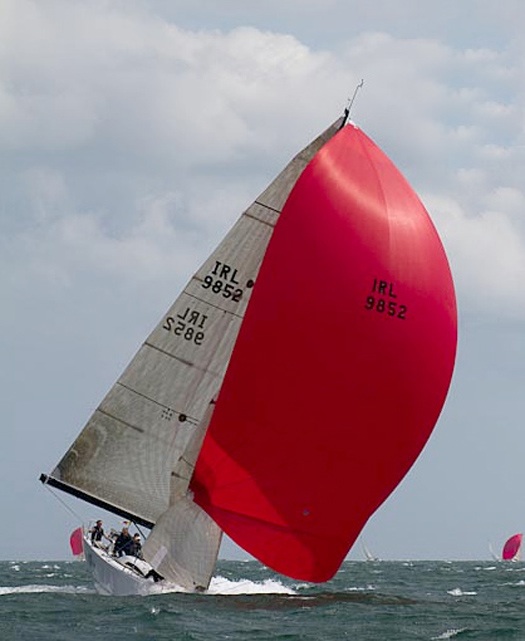
In all her glory. A little bit of sport for Crazy Horse and her crew, some of whom have been sailing with current ICRA Commodore Nobby Reilly for very many years. Photo: Gareth Craig
Next up on the programme after the Come Sailing Day is the ICRA Nationals on Dublin Bay, run from June 13th to 15th in conjunction with the Royal Irish YC. Fleet numbers are already pushing towards a satisfactory level at the hundred-plus mark, but inevitably there will be an East Coast emphasis as there's a biennial Cork Week this year in July.
Time was when the keenest boats and crews would happily take in the Scottish Series, the ICRA Nationals, the Round Ireland Race, Cork Week and the West Cork Regattas, all in one season. But times are changing. We're still recovering from an economic recession which clipped all wings. But there are signs in any case that amateur sailors increasingly prefer to put all their campaigning effort into one big chosen event, and make do with a selection of smaller local series for the rest of the season.
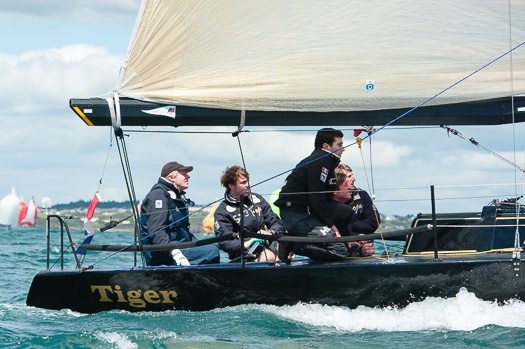
The Kenefick family's front rank Quarter Tonner Tiger from Cork will be racing ICRA Week 2014 in Dun Laoghaire as Nathan Kirwan Trust in a fund-raising campaign. Photo: Robert Bateman
It's those family demands again, something which is now so dominant that anyone of the webbed-foot tendency who expects to sail flat out from one end of the season to the other is regarded as a bit odd. So a viewpoint put forward by Afloat.ie's Water Rat about the need to rationalise the events programme even further is worthy of consideration. But for now the 2014 programme is under way, and it will be instructive to see how it develops, and how the ICRA Executive reacts.
For in addition to many members being involved in the Round Ireland at the end of June, three weeks later the 2014 Commodore's Cup is being staged at Cowes from July 19th to 26th, and Ireland is very much back in the fray after deferring to economic force majeur in 2012, when they didn't mount a defence of their 2010 victory.
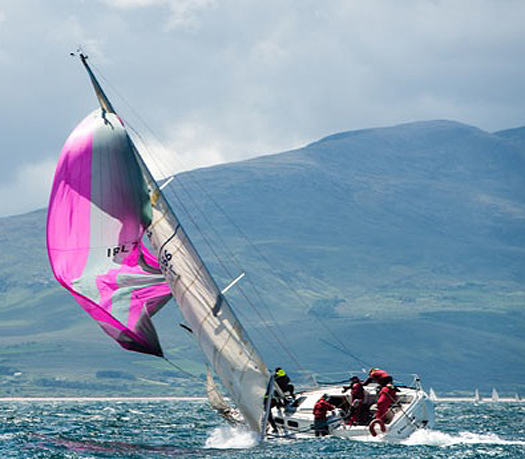
It's Kerry – big mountains, big winds, and all the sport of the ICRA Nationals 2013 at Tralee Bay SC. Photo: Robert Bateman
But at the same time the WIORA Championship is being staged on Clew Bay by Mayo YC. Clew Bay is just about as far as you can get if sailing there from the main sailing centres – once you've passed it, you're heading for home. So there was a plan to take the J/80s there and have clubs send representative crews to race them within the WIORA format. But there's just too much going on, time was against getting it all together for this formidable logistical challenge, so ICRA's man in the west Simon McGibney is concentrating on having the J/80s as a featured part of WIORA Week 2015 in Galway.
Meanwhile, the cruiser-racer and offshore season for 2014 is upon us. ICRA is once again balancing up on the tight-rope, laying on the welcome for newcomers while keeping seasoned campaigners on side. There's no other organisation in Irish sailing life which can think on its feet with the same speed and agility. And the contribution to our sport by the small voluntary staff running this big-hearted operation is a wonder to behold.
Round The Isle of Wight Race Records Lift in First Time Entries
#rtir – There has been a distinct upturn in the number of first timers entering the annual J.P. Morgan Asset Management Round the Island Race since entries opened on January 3rd compared with a few years ago. Early Bird entries have now closed and currently entries stand at over 600. This year's Race takes place on Saturday 21st June, just a week before the Round Ireland race from Wicklow.
First family
American Chris Palmer has entered J Taime, his J/109 (GBR6709R) into her 4th Round the Island Race although Chris has raced the annual 50-nautical mile course a few times on other boats. He lives in London and moved to the UK in 1995 for the weather and the sailing!
Weather permitting it will be the family's first Round the Island Race together, but they have done some inshore IRC racing with Chris in the past, and have cruised J Taime and other yachts. This year is a particularly special race though as the family has agreed to race with Dad to celebrate his 50th birthday.
Chris says that he is hoping that Maddy (13) will be able to steer some sections when the boat is not under too much load. Chris's son, Christopher "Chip" Palmer, will be aged nine on Race day and also on board is big sister Isabella (15) and Mum Gaby (Mexican/British) together with some friends.
First IRC entry
The first IRC entry was Geoff Gritton's Quarter Tonner Panic (GBR7299), a first timer this year. Geoff, from Brightlingsea in Essex, has sailed across the Atlantic twice and sailed dinghies and SB20s.
"MyQuarter Tonner is fully optimised for IRC and is a Peter Gimpel one-off design. I sailed on the boat in 1986 and then bought her in 2011. Since then we have put a new mast and rig and completely replaced the deck gear. I feel very lucky to own this fantastic boat.
"We are a bunch of Essex men just really enjoying our sailing and the banter both on and off the boat. Just because we laugh a lot, that doesn't mean we aren't serious about our racing. We win most races we enter on the East Coast but we love coming to the sailing mecca that is Cowes to learn how to become even better," writes Geoff on his entry form.
First overseas entry is VIP
Another first time entry from M Fabrice Sobczak from Mons in Belgium is actually named VIP (FRA37835), a Beneteau First 35. Fabrice is joined for the Race by friends coming from the Belgium Rugby Club of Mons (former players and supporters) who appreciate sailing together.
The generation game
As one of the highlights of the annual yacht racing calendar, competing in and completing the Round the Island Race is a noteworthy achievement for sailors of all ages to add to their sailing CV and Race entries span every age group and level of experience and ability.
A J/80 called J-Wife (GBR751) has been entered by first timer Simon Watson from Berkhamsted in Hertfordshire. Three generations are racing J-Wife; grandfather Roger (78), his son Simon (46) and grandson Angus (15) and there's not a wife in sight. We're guessing that the boat demands rather more of their time than the women in their lives!
Fundraising for the Ellen MacArthur Cancer Trust
Ocean Odysea (GBR3490L) is a Bavaria 45 entered by Duncan Smith, RYA, YM Instructor and Principal of Waterfront Sailing Academy based in Brighton and is the first entry to declare that they are fundraising for the official Race charity, the Ellen MacArthur Cancer Trust (EMCT). The boat will be crewed by a group of students undergoing RYA training. Duncan's son Darran, is skippering Med Odysea (GBR3491L), a Bavaria 39 and is also fund-raising for the EMCT.
Don't forget that in the lead up to and during the Race weekend, everyone can help raise funds for the EMCT by simply using the hashtag #raceforall and Race Title Sponsor J.P. Morgan will donate £1 per tweet to the Ellen MacArthur Cancer
World renowned St. Francis Yacht Club (StFYC) is seeking a full-time Race Manager, to run all aspects of the Club's Racing programme. The Club operates a year-round regatta schedule with all aspects of competitive sailing: kites, sailboards, dinghies, keelboats, match and team racing. International applicants are welcome.
For more information please visit www.stfyc.com or email resume to [email protected]





























